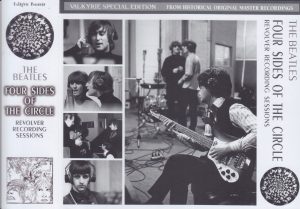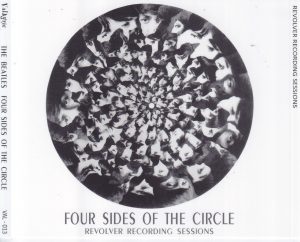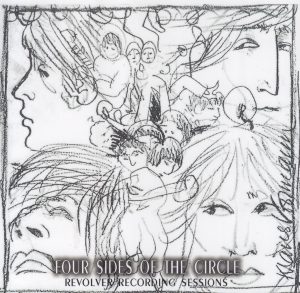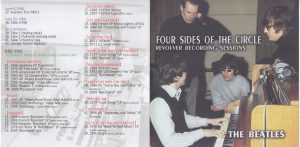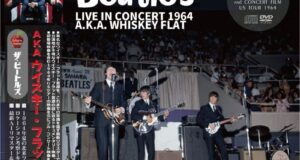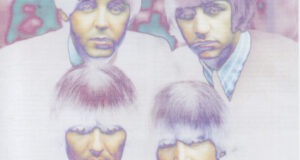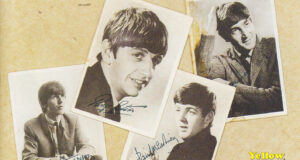Beatles / Four Sides Of The Circle /5CD Wx Slip Case/ Valkyric
Translated text:
Four Sides Of The Circle Revolver Recording Sessions. Digitally Remastered
Click Image To Enlarge
The Beatles’ revolver has become a new era album that uniquely identifies what it was. The music nature of the Beatles that extended the Oldies of the 50’s left the residue up to around “BEATLES FOR SALE”, the treatment of the world is idle, and actually “HELP” has “four people The idol “is given to the title. But the high artistic glimpse of that “HELP” was deepened with “RUBBER SOUL”, indicating that the Beatles were becoming an existence that does not fit within the idol category of one. Until then, I had been doing a tour in parallel with recording, but after stopping the tour in 1966, I will combine the styling of studio work and make ‘Sargent Peppers’. This album gets a high reputation both inside and outside, but it seems that “revolver” was the reason for its production. Indeed there are also reasons for time, but there are many songs that are difficult to reproduce on the stage with the technology at the time, without having played one song from the “revolver” at the stage. The “Paperback · Writer” which was the same period recording that was only released as a single was only played on the 1966 tour, “Rain” on the reverse side uses reverse rotation of the tape It was impossible. The Beatles must have perceived the real pleasure and entertainment of studio production with ‘revolver’. It should have thought that if it takes more time it will be able to create a more dense album. That was connected to Sargent Pepper’s discontinuance of the tour activity afterwards. The album at the time when it is a branch point of album production parallel to the tour and album production which staged in the studio is “revolver”. This work is a title that recorded outtakes and various versions.
【PAPERBACK WRITER】
Recording of ‘Revolver’ was held for about two and a half months from April 6, 1966. The first thing that was undertaken is the single-sided facet of the 12th Beatles ‘Paperback Writer’ and ‘Rain’. This song was the first song to introduce a loudspeaker that emphasizes the baseline, and Paul’s bass was the key to the Beatles sound with this song as the boundary. Takes 1 and 2 for the session on April 13. Take 1 is a breakdown with Paul’s misunderstanding “OK, Go!”. It is recorded here that George and Ringo are also expressing opinions to Paul in the studio. Take 2 is complete, but devoted to playing without vocals. I hear the singing that “Paipaba ~” of the break part is singing with pale silhouette thinly. During the session on April 14th, work is being carried out on vocals and chorus on the backing recorded two days ago. Paul ‘s vocals are recorded separately twice, and finally it is a finished version by overlapping it. In this work, each of the two vocals is separately recorded. Because the chorus has been recorded in the same process, it sounds quite clear, such as John ‘s voice. The vocals and chorus recorded separately this time were superimposed on the track 7 and it became solid by the 4 × 2 8 Beatles.
【RAIN】
“Painback Writer” on the same day as “Rain” has also been recorded. This song is known for songwriting John ‘s lazy singing and it is the first time that mysterious effect sounds using reverse rotation of the tape are scattered around everywhere. As for listening, John’s main vocal is not included, it will be take 5 of only the chorus part. Unlike that naughty vocal, I can understand that the backing voice of John of back and chorus supports this song on the back. Although backing aimed at the effect that slows down the tape speed and slows down, the vocal was recorded by raising the tape speed intentionally rather than at the time of recording and overlapping them, in addition to the reverse rotation of the tape, it is completed by a complicated method I think that I want you to feel a part of it with this work. Although apple himself’s best play and self-praising drum’s evaluation is a high song, at the same time Paul’s base is also wonderfully ingenious, as if it is lead-based.
【TAXMAN】
It is unusual for George’s song to decorate the beginning of the album. “Revolver” is noted for the first time that three songs of George’s work are recorded. John and Paul would have recognized the talent of George who was late. The content of the lyrics is sarcastic, like George’s walking down the town is taxed to the feet. Securing social security expenses is a political issue in Japan where the aging of the population continues, but the Wilson administration in the UK in the 1960s has already imposed a high tax rate on rich people to expand social security expenditures at this time, The names of politicians such as Wilson and Heath are included in the chorus. Recording began on April 21st. In “Paperback Writer”, vocal and chorus were recorded twice separately to create superb vocal effects by overlapping them, but “Taxman” introduces technology called Artificial Double Tracking (ADT) for the first time . This is an epoch-making thing which obtains the same effect by superposing the same sound sour
【ELEANOR RIGBY】
It is the song which became the single of the Beatles 13 songs following “Paperback Writer / Rain”. It is a glimpse of the power relationship at this time in the band that releases a song that is not a rock, and a real Paul’s solo song as a single. Paul is playing this song preference likewise in the current live, but at that time it is reproduced only with the keyboard of Wicks and later with the chorus only. Paul took the vocal so far, John and George chorus. The apple is not participating in the recording. The accompaniment was only string octets, and the score was taken by George Martin. It was said that there was a request from Paul with feeling like Vivaldi “Four Seasons”. Indeed I have a cold atmosphere to remember “winter” of the “four seasons”. Track 1 is a demonstration sound source where Paul is playing the guitar and singing. Although the source is unknown, Paul would have recorded at home to let everyone listen. Paul was still skeptical of the ADT used by George and John. In “Eleanor Rigby” Paul sang the vocals quite a bit. In this work, you can enjoy the singing voice of vocal pole of single vocal.
【I’M ONLY SLEEPING】
This song is also known as “Rain” and reverse rotation of the tape is used as a sound effect. In common with “Rain” is that it aimed at a feeling of bad mood, especially in this song it is consistent with the title. Take 1 is Akogi and John is singing vigorously against the title. Rather, George of the chorus looks sleepy. Take 2 is somewhat close to the release · version but there is still nothing to fall asleep, it will be interrupted on the way. Truck 14 is a new vocal superimposed on take 11, and it is still single vocal. When this becomes Take 13, it seems to be a chaotic atmosphere close to the final version, but it still receives the impression of being refreshed with no tape reverse rotation. John ‘s insistence can be seen where he seasoned further without making it complete. Indian style guitar is superimposed on the ending, which is the sticky note of “Love You Too” as it is.
【LOVE YOU TO】
Like the “Eleanor Rigby”, the Beatles are not participating in the performance, inviting external musicians. It is all Indian instruments such as Tabla and Sitar which are the Indian musical instruments that will give George ‘s lifetime, and it is George, not to mention the main vocal. In this work we recorded take 7 that was recorded on April 13.
【HERE THERE AND EVERY WHERE】
Takes 1, 4, and 5 that were recorded on May 26 are recorded. Take 1 is a pole mellow sweet vocal on the front. It is a finish like a demonstration sound source singing quite carefully. Horn classes are not yet granted. Take 4 is a harmony track. Take 14 is a pile of vocals superimposed on take 13. It is very beautiful vocal while quietly making use of falsetto. Take 14 is still a single vocal, recording a different vocal to overlay on June 17. That is the track 24. It makes a lively vocalization with a voice that is relatively close to the voicel for the first vocal and you can inquire about the intention of Paul singing by changing the voice tone.
【YELLOW SUBMARINE】
Not only the Beatles era, but also representative songs of apple. “Eleanor Rigby” is a title song of animation movie released as a single in both A-side treatment. Credits are traditionally Lennon McCartney, but it is a song of Real Paul. The session of May 26th, Take 1 is recorded with the conversation of George, John, and apple. As George says “Maru!”, It is consistent with the record that Roddy’s Mar also participated in the recording. Take 4 started by John’s count, the cutting of the guitar is very simple and it is an orchestra recording before singing. The following take 5 is an apple vocal track. The apple is singing simple by himself, and the chorus is also a live song without dubbing being superimposed. Track 34 is a truck with a drunk sailor-like John’s hand. In the session on June 1, the date changed, an apple story was added to the intro. Track 36 is the sound effect track added to the song. Take 5 earlier is the basis, and chorus and sound effects are superimposed and it is the last version. Tracks 37 to 41 contain the process of overlapping recorded tracks. The following brass section was recorded on June 2nd.
【SHE SAID SHE SAID】
It is a mysterious song of John whose influence of drag comes out to Moro. Episode that Peter said “I know what death is,” when John tried with an actor Peter Fonda and dragged and John interrupted it as “I do not want to know that” Is the origin of the song. Although the title was “She”, although the word sense might have been good, there was also the purpose to hide Peter Fonda (= He). Because there were quarrels between the members at the time of recording, Paul was defiantly leaving the studio, so there was an episode that the recording was done by three people except Paul. While the “Taxman” guitar was in charge of Paul, George was playing the base of this song. First recorded is a demonstration sound source of John alone playing Akogi. Melody is also incomplete one that is similar to the final version. The lyrics are still “He”. It is interesting that John tried and error, changing the tempo, changing the melody and changing the singing voice.
【GOOD DAY SUNSHINE】
It is a rare and unusually recorded song in “Revolver”, Paul is singing while playing the piano, the other members are only chorus participants. Paul became a solo and re-recorded with the movie “Broad Street”, and he is performing for the first time on stage at the 1989 getback tour. However, George Martin is playing only interlude.
【AND YOUR BIRD CAN SING】
It is a masterpiece full of running performance. Impressive twin guitar played from the intro is performed by George and Paul. In the session on April 20th, dubbing is overlapped on take 2. John is singing relatively seriously, and it is a pretty interesting take, such as putting a break in the part of “Mi” which becomes a texture of rust. George is a frustrating guitar solo to the ending. Anyway George and Paul’s twin guitar are the songs of the listening place, so it seems that the guitar has been recorded with several copies. It is very interesting such as interlude guitar solo and so on. Also, the take that all the members recorded also in the anthology laughs out is the one at the time of vocal recording to take 2 of this day. The anthology’s commentary stated “There was something interesting”, but this is a typical symptom after aspiration of marijuana, hiding in George Martin and sucking in the studio with everyone I guess. In the session of April 26, this song’s re-recording is done again. Take 10 contains the guitar cutting by John. And attention is track 36. John’s vocal track is single, it is a wonderful take that is singing in a lively voice. Although it is inferior in terms of thickness as compared with the next ADT vocal, even with no instruments, it is a singing enough that songs’ charm is transmitted sufficiently only with John’s vocals.
【FOR NO ONE】
“Here There And Everywhere” in addition to mentioning that John is Paul’s favorite song masterpieces. Although it may not have been able to spend time in the session which members gathered, since this song is basically Paul alone recording with piano, the appearance that the take repeatedly is recorded is recorded ing. The session on May 9 is overlapping piano phrases that are the core of the song from take 1 to take 9. Because only the piano and drums are playing, only two of Paul and Ringo are in the studio. The final adoption was take 10. On track 11 you can listen to vocals of raw poles without processing. Impressive French horn has not been added yet, it is a very simple pole playing. The French horn contains two versions, one in which it became bogged and one adopted.
【DOCTOR ROBERT】
It is said that John sang a doctor prescribing drugs. It is a song of the Beatles royal road pattern that John ‘s vocal runs to an intense guitar riff and Paul’ s chorus follows. Although the songs themselves may be mediocrity, there is a part like the breath of Middle, so that the songs are sharp and have a good masterpiece. In track 16, there is a part not included in the release version in the ending, and the end of the song is also different and interesting. I still have not decided how to do the ending, it ended mistakenly, and it seems that John is saying “OK …” to the members.
【I WANT TO TELL YOU】 It
was a song selected for opening number in George ‘s Japan tour in 1991. In the live it was sung as “WANNA”. Track 19 is a short story of the studio during the recording of this song.
【GOT TO GET YOU INTO MY LIFE】
In a song including a flashy horn section, Paul likes even his own solo tour, including Wings’ era, and especially the 1979 tour is decorating the opening. It is a song which should also be said as a brush lock of the Brass Rock which will be sweeping the United States later. Take 5 is a simple working version also included in the anthology, and lyrics not included in the final version are also included, and differences in song composition are also seen. Featured is another vocal recorded on June 20. It is impressive that Paul is singing lively as the tempo is accelerated from the final version.
【TOMORROW NEVER KNOWS】
John ‘s “Tomorrow Never Knows” is the perfect chaos word to decorate the last album. It is a song that embodied the pioneering of the Beatles full of John’s vocals, extremely processed vocals, a number of sound effects and sound reversal of tape, all of which John’s view of the world is impossible for Paul. I am amazed by the speed of the growth of the Beatles that arrives at such a point in just a few years since the days when he played Oldies style rock and roll. Take 1 is a vocal effect that you can dare to hear from AM Radio in line with a monotonous code, and John is singing indiscriminately. It will be a singing turn that intentionally kept intonation. Take 3 that was recorded on April 27 has no effect on John’s vocals and is a live song. Sound effects etc. close to the final version are added at this point. It can be said that it plays the role of trailer to foresee the next Sargent Peppers.
【ALTERNATE MIXES & WORLDWIDE VARIATIONS】
As the times of the Beatles’ album have been moderate, it is known that there are many mix differences among countries around the world. For famous ones, UK MATRIX 1’s “Tomorrow Never Knows” etc may be totally different things. It is the last disk that gathered mix differences of such worldwide boards. Listening and listening in this way will be surprised as to whether it is different even though it is the same song.
【FOUR SIDES OF THE CIRCLE】
The album “REVOLVER” was already completed at the time of the Japanese performance at the end of June 1966, as you can see from the date of recording. However, because it used a complex studio effect, what actually was played on the stage is only one song of “Paperback Writer” released in single. Paul is playing at the stage since Paul became his own solo in the later years is largely based on the development of the equipment, but not only that but Paul is playing solo concerts on all this track Even by looking at it, it would be a proof that this was the time when Paul talent was the most fulfilling period. The album / artwork was also trial-and-error, initially a collage of the Beatles’ photographs in a circle was nominated, and the title was “FOUR SIDES OF THE CIRCLE” (4 sides of the circle) and word play and “ABRACADABRA” A title which imagined chaos was considered, such as. There is also an urban legend that the title of the album finished recording was not determined at all and the inspiration was inspired by a rotary pistol carried by a security guard in Japan. After all, album · jacket was handled by old-fashioned Klaus Bohman. Its workmanship is wonderful, and we will ask again the artwork of “Anthology” later. This work is a compiled title of this “REVOLVER” studio session. Permanent preservation of a beautiful picture disk specification A tightly pressed board.
ビートルズのリボルバーは、それが何であるかを独自に識別する新しい時代のアルバムとなっています。 50年代のオールディーズを拡張したビートルズの音楽性は、「ビートルズ・セール」の周りに残され、世界の治療はアイドルであり、実際には「ヘルパ」には「アイドル」の4人のタイトルが与えられている。しかし、 “HELP”の高い芸術的な垣間見は、 “RUBBER SOUL”で深くなり、ビートルズがアイドルのカテゴリーに合わない存在になっていたことを示しています。それまではレコーディングと並行してツアーをしていましたが、1966年にツアーを中止した後、スタジオのスタイリングを組み合わせて ‘Sargent Peppers’を作っていきます。このアルバムは、内外の高い評価を得ていますが、「リボルバー」がその生産の理由だったようです。確かに時間の理由もありますが、ステージで「リボルバー」から1曲を演奏することなく、当時の技術でステージ上で再現するのが難しい曲がたくさんあります。同じ時期に録音された「Paperback・Writer」は、1966年のツアーでのみリリースされたもので、裏側の「Rain」はテープの逆回転を利用していた。ビートルズはスタジオプロダクションの本当の喜びとエンターテイメントを「リボルバー」と認識していたに違いない。それはより多くの時間がかかる場合は、より高密度のアルバムを作成することができるだろうと考えていたはずです。それは後にサージェント・ペッパーのツアー活動の中断につながった。スタジオで行われたツアーやアルバム制作に並行したアルバム制作の分岐点であるアルバムは、「リボルバー」です。この作品は、アウトテイクや様々なバージョンを記録したタイトルです。
【ペーパーバックの作家】
「リボルバー」の録音は、1966年4月6日から約2ヶ月半かけて行われた。最初に行われたのは、第12回ビートルズ「ペーパーバック・ライター」と「雨」の片面である。この曲は、ベースラインを強調するラウドスピーカーを導入した最初の曲で、この曲を境界としてビートルズの鍵となるのはポールのベースです。 4月13日のセッションでは1と2をとります。Take 1はPaulの誤解「OK、Go!」との内訳です。ここでジョージとリンゴもスタジオのポールに意見を表明していると記録されています。 Take 2は完成しましたが、ボーカルなしで演奏することに専念しています。ブレーク部分の「パイパバ〜」が淡いシルエットで薄く歌っている歌が聞こえます。 4月14日のセッションでは、2日前に録音されたバッキングでボーカルとコーラスが行われています。ポールのボーカルは別々に2回録音され、最終的にはそれをオーバーラップさせて完成したバージョンです。この作品では、2つのボーカルのそれぞれが別々に録音されています。コーラスは同じプロセスで録音されているので、ジョンの声のようにはっきりと聞こえます。この時に別々に録音されたボーカルとコーラスはトラック7に重ねて表示され、4×2 8ビートルズで堅実になりました。
【雨】
雨と同じ日の “Painback Writer”も録音されています。この曲は、Johnの怠惰な歌を歌っていることで知られています。テープの逆回転を使った不思議なエフェクト音がどこにでも散りばめられています。リスニングでは、ジョンの主なボーカルは含まれていません。コーラスパートだけを5つ取ります。そのいたずらなボーカルとは違って、私は背中のジョンの裏声とコーラスがこの曲を背中に支えていることを理解できます。テープのスピードを遅くしてスピードを落とす効果を目的としたバッキングでは、録音時とオーバーラップ時ではなく意図的にテープスピードを上げてボーカルを録音したが、テープの逆回転に加えて複雑な方法で、私はあなたがこの作品でその一部を感じて欲しいと思います。リンゴ自身の最高の演奏と自己称賛のドラムの評価は高い曲ですが、同時にポールの基盤もまるで鉛ベースのように素晴らしく独創的です。
【タクマン】
ジョージの曲がアルバムの初めを飾るのは珍しいことです。 「リボルバー」はジョージの作品の3曲が初めて録音されたことで知られています。ジョンとポールは遅れていたジョージの才能を認めていたでしょう。歌詞の内容は風刺的です。ジョージが街を歩いているように、足に課税されます。日本の社会保障費の確保は人口の高齢化が続いている政治問題であるが、1960年代のイギリスのウィルソン政権は、すでにこの時期に社会保障支出を拡大するために富裕層に対して高い税率を課している。ウィルソンやヒースのような政治家がコーラスに含まれています。録音は4月21日に始まりました。 「ペーパーバックライター」では、ヴォーカルとコーラスを別々に2回録音してオーバーラップさせることで素晴らしいボーカルエフェクトを作成しましたが、初めて “Artificial Double Tracking(ADT)”というテクノロジーを導入しました。これは同じサウンドを重ね合わせることで同じ効果を得る画期的なものです
【エリナー・リグビー】
“Paperback Writer / Rain”に続くBeatles 13曲のシングルとなった曲です。現時点でバンドではロックではない曲をリリースするパワー関係と、シングルとしての本当のポールのソロ曲を垣間見ることができます。ポールは現在のライブでも同様にこの曲の好みを演奏していますが、その時点ではWicksのキーボードだけで再生され、後ではコーラスのみで再生されます。ポールは、これまでボーカル、ジョンとジョージのコーラスを取った。リンゴは録音に参加していません。伴奏は弦の八重奏だけであり、スコアはGeorge Martinによって取られた。ビバルディ「四季」のような気持ちでポールからの要請があったと言われました。確かに、私は “四季”の “冬”を思い出す冷たい雰囲気があります。トラック1は、ポールがギターを弾いて歌っているデモ音源です。音源は不明だが、パウロは家庭で録音してみんなが聞くことができるだろう。ポールはまだジョージとジョンによって使用されるADTに懐疑的でした。 “Eleanor Rigby”では、Paulはボーカルをかなり歌いました。この作品では、シングルボーカルのボーカルポールの歌声を楽しむことができます。
【唯一眠っている】
この曲は「雨」とも呼ばれ、テープの逆回転を効果音として使用します。それと共通して “雨”は、悪い気分の気持ちを狙ったもので、特にこの曲ではタイトルと一致しています。 Take 1はAkogi、Johnはタイトルに対して激しく歌います。むしろ、コーラスのジョージは眠く見えます。テイク2はリリース・バージョンに幾分近いですが、まだ眠ることはありません。途中で中断されます。トラック14はテイク11に重畳された新しいボーカルであり、まだシングルボーカルです。これがテイク13になると、最終バージョンに近いカオス的な雰囲気のようですが、まだテープ逆転なしでリフレッシュされているという印象を受けます。ジョンの主張は、完璧させずにさらに味付けしたところで見ることができます。インディアンスタイルのギターはエンディングの上に重ねられています。これはそのまま “Love You Too”の付箋です。
【あなたを愛しています】
「Eleanor Rigby」のように、ビートルズは外部のミュージシャンを招いてパフォーマンスに参加していません。 TablaやSitarのようなインドの楽器はすべて、ジョージの生涯を与えるインドの楽器であり、主なボーカルはもちろん、ジョージです。この作品では、4月13日に録音されたテイク7を録音しました。
【どこにもどこにでも】
5月26日に記録された1、4、5の記録が記録されます。テイク1は正面のポール・メロウ・スウィート・ボーカルです。デモ音源のような仕上がりで、とても慎重に歌います。ホーンクラスはまだ許可されていません。 Take 4はハーモニートラックです。テイク14はテイク13に重なったボーカルの山です。静かにファルセットを使いながらとても美しいボーカルです。テイク14はまだ6月17日にオーバーレイするために別のボーカルを録音したシングルボーカルです。それはトラック24です。最初のボーカルのボイセルに比較的近いボイスで活発なボーカリゼーションを行い、その意図について問い合わせることができますポールは歌声を変えて歌います。
【イエローサブマリン】
ビートルズの時代だけでなく、リンゴの代表曲もあります。 「Eleanor Rigby」は、A面の両方の治療でシングルとしてリリースされたアニメーション映画のタイトル曲です。クレジットは伝統的にレノン・マッカートニーですが、それはリアル・ポールの歌です。 5月26日のセッション、Take 1はジョージ、ジョン、リンゴの会話で記録されています。 Georgeが “Maru!”と言うように、Roddy’s Marもレコーディングに参加したという記録と一致しています。ジョンのカウントによって開始された4を取る、ギターのカットは非常に簡単であり、それは歌う前に録音オーケストラです。次のテイク5は、リンゴのボーカルトラックです。リンゴは自分でシンプルに歌い、コーラスはダビングしないライブ・ソングでもあります。トラック34は、酔ったセーラーのようなジョンの手のあるトラックです。 6月1日のセッションでは、日付が変わり、リンゴの物語がイントロに追加されました。トラック36は、ソングに追加された効果音トラックです。テイク5は早い段階でベースとなり、コーラスと効果音が重なり合って最後のバージョンになります。トラック37〜41は、記録されたトラックをオーバーラップさせるプロセスを含む。 6月2日に次の真ちゅうセクションが記録されました。
【SHE SAID SAID】
それはドラッグの影響がモロに及ぶジョンの神秘的な歌です。ジョンが俳優のピーター・フォンダと一緒に挑戦して引っ張ったとき、ジョンがそれを中断したときに、「私はそれが何であるかを知っている」とのピーターのエピソードを聞いた。タイトルは「彼女」でしたが、言葉のセンスは良いかもしれませんが、ピーター・フォンダ(=彼)を隠す目的もありました。録音時にメンバー同士の喧嘩があったので、ポールは挑発的にスタジオを離れていたので、ポール以外の3人で録音が行われたというエピソードがありました。 “Taxman”ギターがポールを担当していた間、ジョージはこの曲のベースを演奏していました。最初に録音されたのは、Akogiを演奏するJohnのデモ音源です。メロディーも最終版に似ている不完全なものです。歌詞はまだ “彼”です。ジョンが試行錯誤し、テンポを変えたり、メロディーを変えたり、歌声を変えたりするのは面白いことです。
【グッド・デイ・サンシャイン】
それは “リボルバー”の珍しいと異常に記録された曲、ポールはピアノを弾いて歌っている、他のメンバーはコーラス参加者です。ポールはソロになり、映画「ブロードストリート」に再録音され、1989年のゲットバックツアーでステージで初めて演奏しています。しかし、ジョージ・マーティンは間奏だけを演奏している。
【あなたの鳥は死ぬ】
ランニングパフォーマンスに溢れた傑作です。イントロから演奏された印象的なツインギターはGeorgeとPaulによって演奏されています。 4月20日のセッションでは、テイク2にダビングが重なっています。ジョンは比較的真剣に歌いますが、「Mi」の部分に錆を感じるような休憩を入れるなどかなり面白いテイクです。ジョージはエンディングに残念なギターソロです。とにかくジョージとポールのツインギターは聴く場所の歌なので、ギターはいくつかのコピーで録音されているようです。それは、間奏ギターソロなど、とても面白いです。また、アンソロジーにも収録されているメンバー全員が声を掛けて笑い出しているのは、ボーカルレコーディング時のもので、今日の2時を取ることです。アンソロジーの解説は「興味深いものがあった」と述べましたが、これはマリファナの欲望、ジョージ・マーティンに隠れて、私が推測する誰もがスタジオを吸う典型的な症状です。 4月26日のセッションでは、この曲の再録音が再び行われます。 Take 10には、Johnによるギターカットが含まれています。注意はトラック36です。ジョンのボーカルトラックはシングルで、活発な声で歌う素晴らしいテイクです。楽器がなくても次のADTのボーカルに比べて厚みが劣りますが、ジョンのボーカルだけでは曲の魅力が十分に伝わっています。
【何のためにも】
ジョンがポールの好きな歌の傑作であることに加えて、「ここにはどこにでもあります。集めたセッションでは時間を費やすことができなかったかもしれませんが、この曲は基本的にピアノで録音したポールだけなので、繰り返しテイクが録音されている様子が記録されています。 5月9日のセッションでは、テイク1から9までの曲の中核をなすピアノフレーズが重なっています。ピアノとドラムのみが演奏されているので、PaulとRingoの2人だけがスタジオにいます。最終的な採用は10であった。トラック11では、未加工の極のボーカルを処理せずに聴くことができる。印象的なフレンチホーンはまだ追加されていません、それは非常に単純なポールの演奏です。フレンチホーンには2つのバージョンがあり、1つはボグ、もう1つは採用されています。
【ドクターロバート】
ジョンは医者が薬を処方して歌ったと言われています。ビートルズのロイヤル・ロード・パターンの曲で、ジョンのボーカルは激しいギター・リフとポールのコーラスに続くものです。曲自体は平凡なものかもしれませんが、ミドルの息子のような部分があり、曲が鋭く、傑作があります。トラック16には、エンディングのリリースバージョンに含まれていない部分があり、曲の終わりも違って面白いです。私はまだ結末を決めるつもりはなかったが、それは間違って終わってしまった。そしてジョンは「OK …」と言っているようだ。
【あなたに伝えたい】それは
1991年にジョージの日本ツアーでオープニングナンバーのために選ばれた曲だった。ライブでは “WANNA”と歌われた。トラック19は、この曲の録音中のスタジオの短編です。
【私の生活の中に入ってください
派手なホーンセクションを含むソングでは、ポールはウィングズの時代を含む自分のソロツアーも好きで、特に1979年のツアーではオープニングを飾っています。それは後に米国を掃引するブラスロックのブラシロックとも言われるべき歌です。 Take 5は、アンソロジーにも含まれているシンプルな作業バージョンであり、最終バージョンに含まれていない歌詞も含まれており、曲の構成の違いも見られます。 6月20日に録音された別のヴォーカルが特集されています。最終バージョンからテンポが加速されるので、ポールは活発に歌います。
【まったく知りません
ジョンの “Tomorrow Never Knows”は、最後のアルバムを飾る完璧な混沌の言葉です。これは、ジョンのボーカル、非常に処理されたボーカル、数多くの効果音、テープの音の逆転など、ビートルズの先駆けを体現したもので、ジョンの世界観はポールにとって不可能です。私は昔のスタイルのロックンロールをしてから数年のうちに、このような時点で到着するビートルズの成長のスピードに驚いています。 Take 1は単調なコードに沿ってAMラジオから聴くことを敢えてできるボーカル・エフェクトです。ジョンは無差別に歌います。意図的にイントネーションを鳴らした歌うターンになるでしょう。 4月27日に録音されたテイク3は、ジョンのボーカルに影響を与えず、ライブソングです。この時点で、最終バージョンに近いサウンドエフェクトなどが追加されます。それは次のサージェントペッパーズを予見するための予告編の役割を果たしていると言えます。
【オルタネート・ワールドワイドバリエーション】
ビートルズのアルバムが穏やかな時代になると、世界中の国々のミックスの違いが多いことが知られています。有名人にとっては、英国のMATRIX 1の「Tomorrow Never Knows」などはまったく違うかもしれません。このような世界的なボードのミックスの違いを集めた最後のディスクです。このようなリスニングとリスニングは、同じ曲でも違うかどうかに驚かされます。
【円周の4つの側面】
アルバム「REVOLVER」は、1966年6月末の日本公演時にすでに収録されており、収録日から見ることができます。しかし、複雑なスタジオエフェクトを使用していたため、ステージで実際に演奏されたのはシングルでリリースされた “Paperback Writer”の1曲だけです。ポールは後の年に彼自身のソロになって以来、ステージ上で演奏されていますが、装置の開発に主に基づいていますが、それだけでなく、ポールはこのトラックすべてでソロコンサートを演奏しています。これはポールの才能が最も充実した時期であったことを証明します。アルバム/アートワークも試行錯誤が行われていたが、最初はビートルズの写真のコラージュがノミネートされ、タイトルは「サークルの4つの辺」(サークルの4辺)と「ワード・プレー」と「ABRACADABRA “カオスを想像していたタイトルが考えられました。アルバムのタイトルが全く決まっていないという街の伝説もあり、インスピレーションは日本の警備員が持っていた回転式ピストルに触発されたものです。結局のところ、アルバム・ジャケットは旧式のクラウス・ボーマンによって扱われました。その技量は素晴らしく、後で「アンソロジー」のアートワークを再度尋ねます。この作品は、この “REVOLVER”スタジオセッションの編集タイトルです。美しい画像ディスク仕様の永続的な保存緊密に押されたボード。
DISC ONE
[PAPERBACK WRITER]
April 13, 1966
01. Take 1 (breakdown / Source 1)
02. Take 1 (breakdown / Source 2)
03. Take 2 (complete backing track)
April 14, 1966
Overdubs onto Take 2
04. First Lead Vocal & Backings + Guitar fills
05. Bass SI (multitrack)
06. Second Lead Vocal & Backings vocals
07. Mixdown full Take with organ SI
08. RM
October 31, 1966
09. RS from Acetate
MULTITRACKS
10. Separation process
11. All Vocals
12. Instrumental
【RAIN】
April 14, 1966
13. Take 4 (monitor mix – partial)
April 16, 1966 14. Take 5 Lead vocal + Bass SI
15. Backwards Tape
16. Take 5 Tambourine + extra vocals SI
17. Backing vocals overdubs Onto Take 6
18. Take 7
19. RM 3
MULTITRACKS
20. George Martin on Backwards Tape
21. Drums on front
【TAXMAN】
April 21, 1966
22. Take 11 Single vocal track (partial)
23. Take 11 ADT vocal
24. Lead Guitar + Tambourine SI
25. More Guitar + Backing vocals SI
26. Take 11 with Overdubs
April 22, 1966
27. Reduction Take 12
28. Backing vocals remake SI
May 16, 1966
29. Intro SI
30. RM 4
June 21, 1966
31. RM 5 & 6 Edit
32. RS 1 & 2 Edit
MULTITRACKS
33. Tape Process
34. Instrumental
DISC TWO
【ELEANOR RIGBY】
01. Demo
April 28, 1966
02. Between Takes 1 & 2 (partial)
03. Take 14
April 29, 1966
04. Take 15 Single vocal track
05. Take 15 Paul vocal overdub
06. John & George Backing SI
June 6, 1966
07. Paul Third vocal SI
08 . Paul Fourth vocal SI
June 7, 1966
09. Acetate test mix
【I’M ONLY SLEEPING】
April 29, 1966 (remake session)
10. Rehearsal
11. Take 1
12. Take 2 (breakdown)
April 27 & May 5, 1966
13. Take 11 with SI
May 6, 1966
14. Vocals SI on Take 11
15. Vocal overdubs w / Guitar SI
May 12, 1966
16. Take 13 RM 5
May 20, 1966
17. Take 13 RS 1
18. Take 13 RS 2
19. Take 13 RM 6
【LOVE YOU TO】
April 13, 1966
20. Take 7 RM 1, 2 & 3 (longer)
【HERE, THERE AND EVERYWHERE】
June 16, 1966
21. Take 7 & Vocal SI from Take 13
22. Take 13 Harmonies SI (partial)
23. Take 14 (Take 13 with vocal SI)
June 17, 1966
24. Second Paul vocal & Lead Guitar SI
Monitor Mixes from Take 14
25. Composite # 1
26. Composite # 2
27. Off Line # 1
28. Off Line # 2
29 .. Off Line # 3
30. Off Line # 4
【YELLOW SUBMARINE】
May 26, 1966
31. Take 1 (partial)
32. Take 4 (complete)
33. Take 5 Vocals Inserts SI # 1 & # 2
34. Take 5 John Vocal Insert SI
June 1, 1966
35. Spoken Intro (partial)
36. Sound & vocal effects
OVERDUBS ONTO TAKE 5
37. Paul backing vocal SI
38. Additional Backing Vocals SI
39. Backing Vocals with Mal on Bass Drum
40. All vocal tracks (multitrack)
41. Take 5 Alternate Sound effects Mix
DISC THREE
【YELLOW SUBMARINE】
June 2, 1966
01. Rough Remix 1 different Brass tape
June 3, 1966
02. Final Brass Band tape mix
03. RM 5
June 22, 1966
04. RS 2
MULTITRACK
05. Instrumental
06. Control Room Monitor Mix
EXTRAS
07. 1968 RM
08. 1996 Enhanced Mix
【SHE SAID SHE SAID】
March 1966 HOME DEMOS
HE SAID HE SAID SESSION 1
09 – Demo # 1
10 – Demo # 2 False Start
11 – Demo # 3
12 – Demo # 4
13 – Demo # 5
HE SAID HE SAID SESSION 2
14. Demo # 6
SHE SAID SHE SAID SESSION 3
15. Demo # 7 w / False Start
16. Demos # 8 & # 9
June 21, 1966
17. RM Acetate
CHANNEL MIX
18. Left (mono)
19. Right (mono)
【GOOD DAY SUNSHINE】
June 8, 1966
20. Take 1 with SI (Left Channel Mix Mono)
June 9, 1966
21. Overdubs onto Take 1 (Right Channel Mix Mono)
June 22, 1966
22. RM 7
23. RS 1
[AND YOUR BIRD CAN SING]
April 20, 1966 SESSION 1
24. Take 2 with Vocal track # 1
25. Take 2 Bass, Guitar & Second Vocals SI
26. Take 2 Vocals Overdub # 3 w / extra guitar solo SI
Take 2 With 27. Three Vocals And SI (1996 Composite)
April 26, 1966 RE-MAKE SESSION
28. Take 3 (Breakdown)
29. Take 6 (Final Only)
30. Take 10 Cymbal, Tambourine Ando Handclaps SI
31. Alternate Guitar SI # 1
32. Take 10 RM 5
33. Guitar SI # 2 re-make (multitrack)
34. Guitar solos comparisons
35. Takes 10 & 6 Unreleased Instrumental
April 27, 1966
36. Takes 10 & 6 no ADT vocals
37. Vocals with ADT (multitrack)
May 12, 1966
38. RM 7 & 8 for the US
May 20, 1966
39. RS 1 & 2 edit for the US
40. RS 1 & 2 edit for the UK
June 7, 1966
41. Acetate Test Mix RM 9 & 10
June 6 & 8, 1966
42. Edit of RM 9 & 10 for the UK
MULTITRACK
43. Instrumental
DISC FOUR
【FOR NO ONE】
May 9, 1966 MONITOR MIXES
01. Rehearsal
02. Take 1
03. Take 2
04. Take 7
05 . Take 8
06. Take 9
May 16, 1966
07. Take 10 SI # 1 (monitor mix # 1)
08. Take 10 SI # 2 (monitor mix # 2)
09. Take 10 SI (monitor mix # 3)
10. Take 10 SI (composite monitor mix)
11. Take 10 SI Clavichord track
12. Take 10 SI Vocal track
May 19, 1966
13. Take 14 SI Alternate Horn (monitor mix)
14. Take 14 SI French Horn
MULTITRACK
15. Take 10 backing track
【DOCTOR ROBERT】
May 12, 1966
16. RM4 for the US
17. Acetate Test Mix
May 20, 1966
18. RS 1 for the US
【I WANT TO TELL YOU】
June 2, 1966
19. Pre-Take 1 (partial)
June 3, 1966
20. RS from Take 4 (full intro)
【GOT TO GET YOU INTO MY LIFE】
April 7, 1966
21. Take 5
May 18, 1966
22. Tape reduction Take 9
CHANNEL MIXES
23. Take 8 partial from 5.1 mix
24. Take 8 with SI (Left Channel / mono)
25. Brass SI # 1 partial from 5.1
26. Brass SI # 2 partial from 5.1
27. Second Vocal SI partial from 5.1
28. Take 9 SI
June 20, 1966
29. RM 8 different vocal at end
June 22, 1966
30. RS1 different vocal at end
EXTRAS
31. RM & RS End comparison JULY, 1966
CLIFF BENNET AND THE REBEL ROUSERS SESSION
32. Paul on Piano and Producer
【TOMORROW NEVER KNOWS】
April 6, 1966
33 Take 1 alternate intro
34. Take 1
April 27, 1966
35. Take 3 RM 8 Mono Matrix II
June 6, 1966
36. Take 3 RM 11 Mono Matrix I
June 8, 1966
37. Acetate Test RM 11
June 22, 1966
38. Take 3 RS 6
MULTITRACKS
39. Take 1 (mixing desk)
40. Take 3 (full end) (mixing desk)
41. Take 3 monitor mix
42. George Martin explains
DISC FIVE
ALTERNATE MIXES & WORLDWIDE VARIATIONS
【PAPERBACK WRITER】
01. 1966 Japanese EP Duophonic
02. 1970 US ‘Hey Jude’ LP Stereo reversed
03. 1979 unreleased US ‘Collector’s Items’ LP Stereo
04. 1982 UK ’20 Greatest Hits’ LP Stereo Center
05. 1983 UK ‘Abbey Road Show’ John Barrett Stereo
06. 1996 ‘Anthology’ Video Mix Stereo
07. 2001 ‘Beatles 1’ Video mix Stereo
08. 2009 ‘Rockband’ mix
【RAIN】
09. 1983 UK ‘Abbey Road Show’ John Barrett Stereo
10. 1996/2003 ‘Anthology’ Video Mix Stereo
11. 1996 ‘Anthology’ Laserdisc Stereo
【TAXMAN】
12. 1966 French ‘Revolver’ LP Mono clean intro
13. 1966 French ‘ Revolver ‘LP Stereo clean intro
14. 1966 Mexican’ Revolver ‘LP Mono clean intro
15. 1976 US “Rock’ N ‘Roll Music” LP Stereo reversed
16. 2009’ Rockband ‘mix
【ELEANOR RIGBY】
17. 1968′ YS Film ‘ Stereo
18. 1987 ‘YS Film’ Laserdisc Stereo
【I’M ONLY SLEEPING】
19. 1966 French EP Mono slightly dif EQ
20. 1966 US “Yesterday and Today” LP Duophonic
【LOVE YOU TOO】
21. 2011 “LITMW” Video Stereo
22. 2011 5.1 separation
【HERE, THERE AND EVERY WHERE】
23. 1977 “Love Songs” LP Stereo reversed
24. 1980 “Ballads” LP Stereo
【YELLOW SUBMARINE】
25. 1968 ‘YS Film’ Stereo
26. 1982 UK ’20 Greatest Hits’ LP Stereo
27. 2009 “Rockband” mix
【AND YOUR BIRD CAN SING】
28. 1996 US “Yesterday and Today” LP Duophonic
29. 2009 “Rockband” mix
【FOR NO ONE】
30. 1977 “Love Songs” LP Stereo reversed
【DR. ROBERT】
31. 1996 US “Yesterday and Today” LP Duophonic
【GOT TO GET YOU INTO MY LIFE】
32. 1976 US “Rock ‘N’ Roll Music” LP Stereo reversed
33. 1976 Single Stereo with echo
Valkyric. VAL-013
 GiGinJapan Artwork of Japanese CDs (mostly)
GiGinJapan Artwork of Japanese CDs (mostly) 